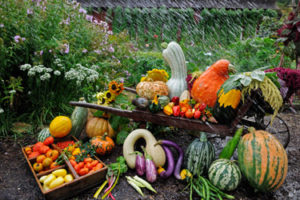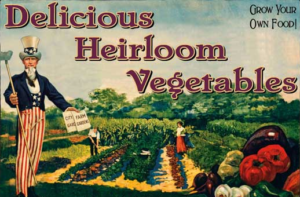PREPPER SUPPLIES: Growing Your Own Food
PREPPER SUPPLIES: Growing Your Own Food
Bobby Akart “Prepping For Tomorrow” Audio in player below!
 The process of gardening is the result of more than tilling, planting, weeding and harvesting. It is also the result of preparedness to overcome challenges such as location, pests and other unforeseen complications like unusual weather. Imagine the pressure a prepper will be under to produce a harvest after TEOTWAWKI when their life depends on it. After the SHTF, an ordinary vegetable garden becomes a survival garden.
The process of gardening is the result of more than tilling, planting, weeding and harvesting. It is also the result of preparedness to overcome challenges such as location, pests and other unforeseen complications like unusual weather. Imagine the pressure a prepper will be under to produce a harvest after TEOTWAWKI when their life depends on it. After the SHTF, an ordinary vegetable garden becomes a survival garden.
Growing Your Own Food is Like Printing Your Own Money
I love that saying because it is true. It can also be modified to read growing your own food will keep you alive when the SHTF.
 As part of your preparedness plan, it is vital to grow a variety of fruits and vegetables where you live. In the future, you will need to replenish your food storage and a survival garden will be your most important self-sustainable tool. Back in the day, everyone grew food; for sustenance during the spring and summer and then it was preserved to feed themselves through the winter. Like all aspects of your preparedness plan, practice is a necessity. Don’t assume that you can learn this important skill after the collapse.
As part of your preparedness plan, it is vital to grow a variety of fruits and vegetables where you live. In the future, you will need to replenish your food storage and a survival garden will be your most important self-sustainable tool. Back in the day, everyone grew food; for sustenance during the spring and summer and then it was preserved to feed themselves through the winter. Like all aspects of your preparedness plan, practice is a necessity. Don’t assume that you can learn this important skill after the collapse.
You won’t know until you try. The first stop should be your local US Department of Agriculture Extension Office. Find out what crops grow best in your area. Take a soil sample and photographs of your proposed garden plot. They will be glad to help you. Talk to your neighbors. I have plenty of old codgers around me who love to dole out free advice. Take this from experience. You will want to practice and experiment with your survival garden now as the learning curve is steep. Trust me.
 The second step is purchasing heirloom seeds. There are two types of seeds — heirloom and genetically modified seeds. When you are buying seeds either online or at a nursery or garden center, look for a seal that says the seeds are non-GMO, genetically modified organisms. There is a HUGE debate about the uses of GMO’s by large corporate farms and I’m neither qualified nor interested in jumping into the fray. There is also a ton of misinformation out there. For preppers, the debate is irrelevant. In order for Preppers to create a sustainable survival garden for years to come, GMO’s won’t work for you. It is important that Preppers plant their survival garden utilizing Heirloom Seeds. For a good infographic explaining all of this, check this out on the Freedom Preppers website:
The second step is purchasing heirloom seeds. There are two types of seeds — heirloom and genetically modified seeds. When you are buying seeds either online or at a nursery or garden center, look for a seal that says the seeds are non-GMO, genetically modified organisms. There is a HUGE debate about the uses of GMO’s by large corporate farms and I’m neither qualified nor interested in jumping into the fray. There is also a ton of misinformation out there. For preppers, the debate is irrelevant. In order for Preppers to create a sustainable survival garden for years to come, GMO’s won’t work for you. It is important that Preppers plant their survival garden utilizing Heirloom Seeds. For a good infographic explaining all of this, check this out on the Freedom Preppers website:
While it’s not required to label a product as being GMO, many seed manufacturers want their customers to know (very few seeds are GMO; namely corn, soybeans, squash and papaya). Some of the online sellers indicate they’re selling more non-GMO seeds because their customers are leery about the effects and sustainability of modified seeds.
Heirloom varieties of fruits and vegetables have a long history and are considered to be “original and purebred,” meaning they haven’t been bred or mixed with any other variety (that would make it a hybrid). There are hundreds of varieties of heirloom plants, some more rare than others, and some that have been around for over one hundred years. They are marketed by all of the major online retailers. I’ve used them all. When shopping, look for the heirloom designation or at least a non-GMO label on these seed packets. Remember the USDA’s advice when choosing your varieties.
After the harvest, you need to learn how to save your seeds for next spring. If you are new to gardening, you might consider an heirloom seed collecting kit. Otherwise, here are some basics to consider:
Saving “Dry” Heirloom Seeds
Many heirloom seeds are fairly easy to save and require little work other than scooping out the seeds, rinsing them off, drying, and storing in a cool, dry place. Sometimes, you must allow the produce to dry out on the vine. These methods work for seeds that aren’t housed in wet, soggy areas; peppers, corn, zucchini and bean seeds. Anytime you’re saving seeds, always choose a good looking fruit or vegetable that is well-shaped, has good color, and is free of any defects. This will ensure you’re only passing on those good genes!
Saving “Wet” Heirloom Seeds
For your heirloom plants whose seeds are contained in a wet, fibrous interior (think melons, tomatoes and cucumbers), pass on their legacy and start a stockpile for the next generation of vegetables. Saving seeds isn’t rocket science — it’s all about fermentation! Sure, it’s a little harder than just pulling out dry seeds and putting them in a bag, but the process isn’t hard.
Once again, choose a very good-looking fruit or vegetable from one of your best plants and cut it across the center. With a spoon, scoop out the seeds and the “gooey” part and place into a cup or container. Add a little water so that the seeds float and cover the lid with a paper towel or plastic wrap.
Set the container in a warm location for three or four days. You may want to place it somewhere you don’t go often – it’s probably going to smell! You’ll know fermentation is done when the seeds settle to the bottom of the container and a layer of reddish mold grows on top. Don’t panic about the mold! Remove the mold and pour the rest of the container into a strainer. Wash the seeds off and lay individually on a towel and let them dry for 5 days or longer. You’ll know the seeds are dry when they don’t stick together. Finally, place your seeds in a small bag or envelope and boom — you’re done!
In Tennessee, we have found that you only have to do the fermentation with tomatoes, completely skipping this method with melons and cucumbers. Experiment a little and check your results in your area.
If you want to read more about gardening, may I suggest visiting thePrepper Broadcasting Book Store.
Remember, from the words of Sitting Bull:
Behold my friends, the spring is come; the earth has gladly received the embraces of the sun and we shall soon see the results of their love!
Visit Bobby Akart website HERE! http://www.bobbyakart.com/
Join us for “Prepping For Tomorrow” “LIVE SHOW” every Thursday 9:00/Et 8:00Ct 6:00/Pt Go To Listen and Chat
Listen to this broadcast or download “PREPPER SUPPLIES: Growing Your Own Food” in player below!
Get the 24/7 app for your smart phone HERE! https://pbnfamily.com/app/
Put the 24/7 player on your web site HERE! https://pbnfamily.com/share-our-players/
Archived shows Prepping For Tomorrow at bottom of THIS PAGE!
Food GMO growing prepper PREPPER SUPPLIES: Growing Your Own Food seeds Supplies survival

